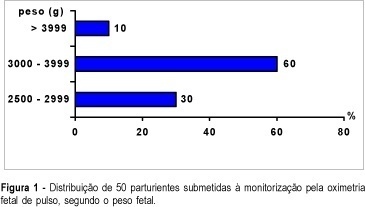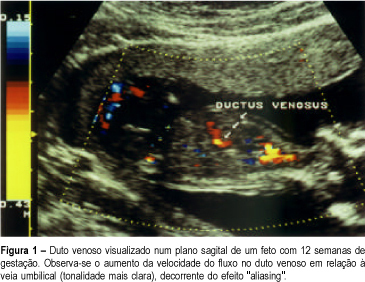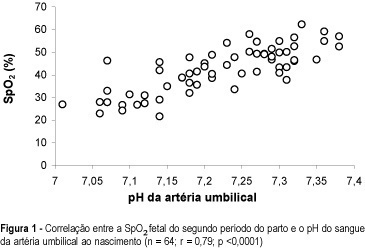Summary
Revista Brasileira de Ginecologia e Obstetrícia. 1999;21(3):141-146
DOI 10.1590/S0100-72031999000300004
Purpose: to study fetal oxygen saturation (SpO2) levels during labor by continuous pulse oximetry tecnique, and its relation to umbilical artery (UA) pH. Patients and Methods: fetal SpO2 levels were measured during labor by the pulse oximetry technique in 50 subjects. Average values of SpO2 were compared between the first and second stage of labor, with the first stage further subdivided into phases, according to cervical dilatation of (<=4 cm, 5-7 cm and 8-9 cm). SpO2 values were studied in relation to umbilical artery pH at birth ( > or = 7.20 and <7.20). SpO2 > or = 30.0% was considered normal. Results: fetal SpO2 averages during the first stage were 53.0 ± 7.3% and 44.2 ± 6.8% (UA pH > or = 7.20 and <7.20, respectively; p<0.01). When the first stage was subdivided, the fetal SpO2 averages (UA pH > or = 7.20) were 55.1 ± 5.1% (<=4 cm), 52.3 ± 4.6% (5-7 cm) and 51.5 ± 7.2% (8-9 cm); for UA pH <7.20, the fetal SpO2 averages were 46.3 ± 5.1% (<=4 cm), 43.6 ± 6.7% (5-7 cm) and 42.8 ± 5.8% (8-9 cm). Considering the UA pH, these differences were statistically significant (p<0.01). Conclusion: a significant decrease of oxygen saturation values was observed during labor when fetal pulse oximetry was used.

Summary
Revista Brasileira de Ginecologia e Obstetrícia. 1999;21(7):409-414
DOI 10.1590/S0100-72031999000700007
Purpose: to determine whether the transfer day or the stage that the embryo is transferred interferes in pregnancy and implantation rates. Methods: oocytes we recovered from 107 patients and submitted to in vitro fertilization. The embryos were cocultured on Vero cells and transferred on day 3 or day 5 post-fertilization, after morphological assessment. Results: the implantation rate of the transferred embryos on day 5 was significantly higher than when the embryos were transferred on day 3, but the pregnacy rates did not change. However, a significant difference was observed in the pregnancy rates for embryos transferred at the expanded blastocyst stage (70.6% of pregnancy) when compared to 20.0% and 10.5% at the earlier blastocyst and morula stages, respectively. Conclusions: the implantation and pregnancy rates were significantly increased when the embryos were transferred at the expanded blastocyst stage, but the culture media and culture conditions now available are not able to provide a satisfactory rate at this stage.
Summary
Revista Brasileira de Ginecologia e Obstetrícia. 1999;21(7):401-405
DOI 10.1590/S0100-72031999000700006
Purpose: to investigate if the addition of a cotton "swab" to the Ayre spatula and its previous moistening with physiologic saline solution increase the obtention of endocervical cells in colpocytologic smears. Methods: a random and single-blind diagnostic study was performed, involving three techniques of collection (Ayre spatula, combination of Ayre-dry cotton swab spatula and combination of Ayre-moist cotton swab spatula). A total of 307 smears prepared by Medicine students and residents of Gynecology and Obstetrics were evaluated. Results: there was no significant increase in the number of endocervical cells (columnar and/or metaplastic), obtained with the addition of dry swab (p = 0.2) or with the addition of a moistened swab (p = 0.8). Conclusions: the author concluded that mainly when the collections were performed by trainee professionals and in the absence of other more effective endocervical collecting device, it is more economical to use only the Ayre spatula to prepare the smear.
Summary
Revista Brasileira de Ginecologia e Obstetrícia. 1999;21(7):393-397
DOI 10.1590/S0100-72031999000700005
Purpose: to evaluate a possible relationship between fetal malformations (FM) and the use of sulfonylureas (SF) by diabetic pregnant women. Methods: we retrospectively studied 35 type 2 diabetic pregnant women followed at the Pathological Prenatal Care Outpatient Clinic of the University Hospital, Faculty of Medicine of Ribeirão Preto, from 1993 to 1995. Twenty-two of these women had been inadvertently using sulfonylureas during the 1st trimester of gestation (SF group). We determined their prevalence of FM and compared it to that observed for pregnant diabetic women who were only on diet or insulin therapy (group C). We also analyzed other variables such as time of disease, age, metabolic control, and prenatal care. Results: there was no significant difference between groups in terms of age range, duration of diabetes, glycemic control, or early start of prenatal care, with the prevalence of FM being similar for the two groups (8.3% in group C and 13.6% in group SF). The malformations observed in group SF were: renal agenesis, pulmonary hypoplasia and ribbon gonads (patient 1); short limbs and abnormally implanted toes (patient 2); cleft palate, low implanted ears, neck webbing and saddle nose (patient 3), and micrognathia, dysplastic ears, imperforate anus, hypospadia, polydactily, ventricular septal defect and atrial septal defect (patient 4) in group C. Conclusions: these data do not allow us to attribute the malformations detected in group SF to the use of sulfonylureas, although not usually described alterations in diabetic embryopathy occurred in this group.
Summary
Revista Brasileira de Ginecologia e Obstetrícia. 1999;21(7):389-392
DOI 10.1590/S0100-72031999000700004
Purpose: to report the personal experience with the use of the amnioinfusion technique in patients in labor presenting meconial amniotic fluid, and the incidence of complications, the meconium aspiration syndrome and of cesarean sections. Method: twenty patients at term and in labor with meconial amniotic fluid were evaluated retrospectively, at the delivery ward at two public institutions of Rio Grande do Sul. An initial infusion of 1.000 ml of normal saline solution at room temperature, at an infusion rate of 20-30 ml per minute was initiated and then reduced to 3 ml per minute. The liquid was drained by elevating the cephalic pole. Results: the procedure was feasible when a nasogastric catheter was used. None of the patients presented major complications related to the procedure. None of the neonates presented meconium below their vocal cords. The cesarean section rate was 3/20 (15%). Conclusion: the amnioinfusion is a low-cost and feasible technique that did not show any complication in this study.
Summary
Revista Brasileira de Ginecologia e Obstetrícia. 1999;21(7):371-376
DOI 10.1590/S0100-72031999000700002
Purpose: to evaluate the possible value of pulsed and color Doppler of ductus venosus blood flow in the screening for chromosomal abnormalities at 10-14 weeks of gestation. Methods: the ductus venosus flow velocity waveforms and the nuchal translucency (NT) thickness were obtained immediately before the chorionic villus sample in 26 pregnancies. We employed the following criteria for the suspicion of chromosomal defects: reverse or absent flow during atrial contraction and NT greater or equal to 3 mm. We calculated the sensitivity, the specificity, the negative and positive predictive value for each of the above items. Results: there were 9 chromosomal abnormalities (3 cases of trisomy 21, 2 cases of trisomy 13, 1 case of trisomy 9, 1 case of trisomy 22, 1 triploidy and 1 monosomy X). Abnormal ductus venosus flow was observed in all cases (sensitivity of 100%). In the normal fetuses (17 cases) only 1 had abnormal flow (specificity of 94%). Concerning NT, the sensitivity and the specificity were 88% and 76%, respectively. Conclusion: our preliminary results suggest that the presence of chromosomal abnormalities may be strongly suspected when an increased NT thickness is associated with an absent or reverse flow in the ductus venosus. We speculated that both methods are valid in the screening of chromosomal defects.

Summary
Revista Brasileira de Ginecologia e Obstetrícia. 1999;21(7):381-384
DOI 10.1590/S0100-72031999000700003
Purpose: to study the correlation between fetal oxygen saturation measured by pulse oximetry during second stage of labor and umbilical artery pH at birth. Patients and Methods: fetal oxygen saturation (FSpO2) was monitored by pulse oximetry during the second stage of labor in 64 singleton pregnancies at term, with vertex presentation. Umbilical blood was sampled immediately after delivery for subsequent measurement of venous and arterial blood gases and pH. All fetuses maintained FSpO2 > or = 30% through the first stage of labor, until the start of second stage. Results: the mean FSpO2 at the second stage of labor correlated significantly with umbilical artery pH at birth (n = 64, r = 0.79, p <0.001). There was no significant corre-lation between FSpO2 at the second stage of labor and umbilical artery oxygen saturation at birth. Conclusion: fetal oxygen saturation measured by pulse oximetry during second stage of labor has a good correlation with umbilical artery pH at birth.

Summary
Revista Brasileira de Ginecologia e Obstetrícia. 1999;21(5):261-266
DOI 10.1590/S0100-72031999000500003
Purpose: to evaluate the immune status of women in reproductive age regarding the rubella virus. Methods: 2,243 samples of serum from women in the age range of 15 to 45 years, with an average of 26 years, living in the urban area of Natal, RN were analyzed, to evaluate the immune status in regard to rubella virus. Of these women, 1,170 (52.1%) were pregnant and 1,073 (47.9%) were not. IgM and IgG antibodies were determined, using solid phase ELISA and fluorescence (ELFA) techniques. Results: of the 2,243 women, 1,632 showed immunity to rubella virus and 611 did not, therefore being susceptible to this virus. The rates of immunity and susceptibility in this study were 73.0% and 27.0%, respectively. In 611 susceptible woman, 14.5% did not present antibodies against rubella virus, 7.7% had only IgM antibody and 4.8% had IgG and IgM antibodies. Conclusions: our findings show that a significant group of women from Natal, in reproductive age, is still susceptible to rubella virus, indicating the risk of congenital infection by this pathogen. We advise the selective vaccination of those women against rubella to prevent clinical manifestations related to the congenital form of the disease.